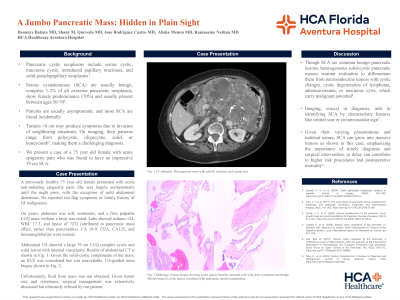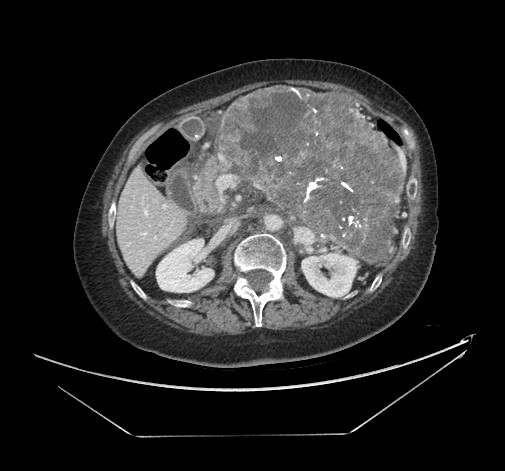Tuesday Poster Session
Category: Biliary/Pancreas
P3554 - A Jumbo Pancreatic Mass: Hidden in Plain Sight
Tuesday, October 29, 2024
10:30 AM - 4:00 PM ET
Location: Exhibit Hall E

Has Audio

Deannys Batista, MD
Aventura Hospital
Miami, FL
Presenting Author(s)
Deannys Batista, MD1, Shany M. Quevedo, MD1, Jose Rodriguez Castro, MD2, Alisha Menon, MD2, Ramasamy Nathan, MD2
1Aventura Hospital, Miami, FL; 2Aventura Hospital, Aventura, FL
Introduction: Pancreatic cystic neoplasms include serous cystic, mucinous cystic, intraductal papillary mucinous, and solid pseudopapillary neoplasms. Serous cystadenomas (SCA) are usually benign, comprise 1-2% of all exocrine pancreatic neoplasms, show female predominance (70%) and usually present between ages 50-70. Patients are usually asymptomatic and most SCA are found incidentally. Tumors >4 cm may produce symptoms due to invasion of neighboring structures. On imaging, their patterns range from polycystic, oligocystic, solid, or honeycomb, making them a challenging diagnosis. We present a case of a 75 year old female with acute epigastric pain who was found to have an impressive 19 cm SCA.
Case Description/Methods: A previously healthy 75 year old female presented with acute non-radiating epigastric pain. She was largely asymptomatic until the night prior, with the exception of mild abdominal distension. No reported red flag symptoms or family history of GI malignancy. On exam, abdomen was soft, nontender, and a firm palpable LUQ mass without a bruit was noted. Labs showed sodium 124, WBC 17.3, and lipase of 7232 (attributed to pancreatic mass effect, not pancreatitis). Abdominal US showed a large 19 cm LUQ complex cystic and solid lesion with internal vascularity. The heterogeneous mass was described as having calcific elements and central scar on CT. CA 19-9, CEA, CA125, and immunoglobulins were normal. Given the solid-cystic components of the mass, an EUS was considered but was unavailable. US-guided mass biopsy showed cystic spaces lined by cuboidal cells with clear cytoplasm and benign fibrous tissue in cystic spaces, consistent with pancreatic serous cystadenoma. Unfortunately, fluid from mass was not obtained. Given tumor size and symptoms, surgical management was extensively discussed but ultimately refused by our patient.
Discussion: Though SCA are common benign pancreatic lesions, heterogeneous solid-cystic pancreatic masses warrant evaluation to differentiate them from neuroendocrine tumors with cystic changes, cystic degeneration of lymphoma, adenocarcinoma, or mucinous cysts, which carry malignant potential. Imaging, crucial in diagnosis, aids in identifying SCA by characteristic features like central scar or circumvascular sign. Given their varying presentations and indolent nature, SCA can grow into massive tumors as shown in this case, emphasizing the importance of timely diagnosis and surgical intervention, as delay can contribute to higher risk procedures and postoperative mortality.

Disclosures:
Deannys Batista, MD1, Shany M. Quevedo, MD1, Jose Rodriguez Castro, MD2, Alisha Menon, MD2, Ramasamy Nathan, MD2. P3554 - A Jumbo Pancreatic Mass: Hidden in Plain Sight, ACG 2024 Annual Scientific Meeting Abstracts. Philadelphia, PA: American College of Gastroenterology.
1Aventura Hospital, Miami, FL; 2Aventura Hospital, Aventura, FL
Introduction: Pancreatic cystic neoplasms include serous cystic, mucinous cystic, intraductal papillary mucinous, and solid pseudopapillary neoplasms. Serous cystadenomas (SCA) are usually benign, comprise 1-2% of all exocrine pancreatic neoplasms, show female predominance (70%) and usually present between ages 50-70. Patients are usually asymptomatic and most SCA are found incidentally. Tumors >4 cm may produce symptoms due to invasion of neighboring structures. On imaging, their patterns range from polycystic, oligocystic, solid, or honeycomb, making them a challenging diagnosis. We present a case of a 75 year old female with acute epigastric pain who was found to have an impressive 19 cm SCA.
Case Description/Methods: A previously healthy 75 year old female presented with acute non-radiating epigastric pain. She was largely asymptomatic until the night prior, with the exception of mild abdominal distension. No reported red flag symptoms or family history of GI malignancy. On exam, abdomen was soft, nontender, and a firm palpable LUQ mass without a bruit was noted. Labs showed sodium 124, WBC 17.3, and lipase of 7232 (attributed to pancreatic mass effect, not pancreatitis). Abdominal US showed a large 19 cm LUQ complex cystic and solid lesion with internal vascularity. The heterogeneous mass was described as having calcific elements and central scar on CT. CA 19-9, CEA, CA125, and immunoglobulins were normal. Given the solid-cystic components of the mass, an EUS was considered but was unavailable. US-guided mass biopsy showed cystic spaces lined by cuboidal cells with clear cytoplasm and benign fibrous tissue in cystic spaces, consistent with pancreatic serous cystadenoma. Unfortunately, fluid from mass was not obtained. Given tumor size and symptoms, surgical management was extensively discussed but ultimately refused by our patient.
Discussion: Though SCA are common benign pancreatic lesions, heterogeneous solid-cystic pancreatic masses warrant evaluation to differentiate them from neuroendocrine tumors with cystic changes, cystic degeneration of lymphoma, adenocarcinoma, or mucinous cysts, which carry malignant potential. Imaging, crucial in diagnosis, aids in identifying SCA by characteristic features like central scar or circumvascular sign. Given their varying presentations and indolent nature, SCA can grow into massive tumors as shown in this case, emphasizing the importance of timely diagnosis and surgical intervention, as delay can contribute to higher risk procedures and postoperative mortality.

Figure: Pancreatic mass
Disclosures:
Deannys Batista indicated no relevant financial relationships.
Shany Quevedo indicated no relevant financial relationships.
Jose Rodriguez Castro indicated no relevant financial relationships.
Alisha Menon indicated no relevant financial relationships.
Ramasamy Nathan indicated no relevant financial relationships.
Deannys Batista, MD1, Shany M. Quevedo, MD1, Jose Rodriguez Castro, MD2, Alisha Menon, MD2, Ramasamy Nathan, MD2. P3554 - A Jumbo Pancreatic Mass: Hidden in Plain Sight, ACG 2024 Annual Scientific Meeting Abstracts. Philadelphia, PA: American College of Gastroenterology.
